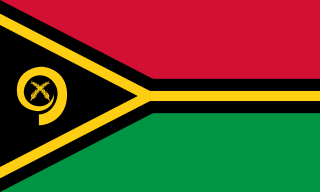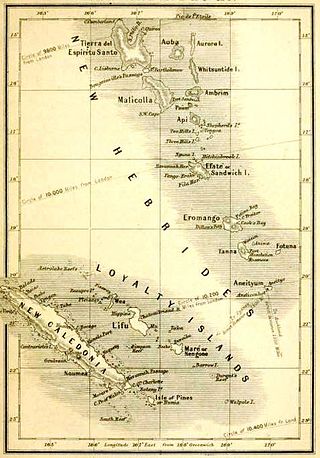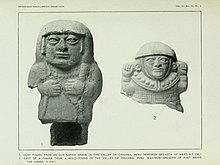
Vanuatu, officially the Republic of Vanuatu, is an island country in Melanesia, located in the South Pacific Ocean. The archipelago, which is of volcanic origin, is 1,750 km (1,090 mi) east of northern Australia, 540 km (340 mi) northeast of New Caledonia, east of New Guinea, southeast of Solomon Islands, and west of Fiji.

The history of Vanuatu spans over 3,200 years.

Melanesia is a subregion of Oceania in the southwestern Pacific Ocean. It extends from New Guinea in the west to the Fiji Islands in the east, and includes the Arafura Sea.
Cargo cult programming is a style of computer programming characterized by the ritual inclusion of code or program structures that serve no real purpose. Cargo cult programming is symptomatic of a programmer not understanding either a bug they were attempting to solve or the apparent solution. The term cargo cult programmer may apply when anyone inexperienced with the problem at hand copies some program code from one place to another with little understanding of how it works or whether it is required.

Pacific Islanders, Pasifika, Pasefika, Pacificans or rarely Pacificers are the peoples of the Pacific Islands. As an ethnic/racial term, it is used to describe the original peoples—inhabitants and diasporas—of any of the three major subregions of Oceania or any other island located in the Pacific Ocean.

John Frum is a figure associated with cargo cults on the island of Tanna in Vanuatu. He is often depicted as an American World War II serviceman who will bring wealth and prosperity to the people if they follow him. Quoting David Attenborough's report of an encounter: "'E look like you. 'E got white face. 'E tall man. 'E live 'long South America."

Melanesians are the predominant and indigenous inhabitants of Melanesia, in an area stretching from New Guinea to the Fiji Islands. Most speak one of the many languages of the Austronesian language family or one of the many unrelated families of Papuan languages. There are several creoles of the region, such as Tok Pisin, Hiri Motu, Solomon Islands Pijin, Bislama, and Papuan Malay.

Tanna is an island in southern Vanuatu.

Polynesian outliers are a number of culturally Polynesian societies that geographically lie outside the main region of Polynesian influence, known as the Polynesian Triangle; instead, Polynesian outliers are scattered in the two other Pacific subregions: Melanesia and Micronesia. Based on archaeological and linguistic analysis, these islands are considered to have been colonized by seafaring Polynesians, mostly from the area of Tonga, Samoa and Tuvalu.
The East Melanesian Islands, also known as the Solomons-Vanuatu-Bismarck moist forests, is a biogeographic region in the Melanesia subregion of Oceania. Biogeographically, the East Melanesian Islands are part of the Australasian realm.

Religion in Papua New Guinea is dominated by various branches of Christianity, with traditional animism and ancestor worship often occurring less openly as another layer underneath or more openly side by side with Christianity. The Catholic Church has a plurality of the population. The courts, government, and general society uphold a constitutional right to freedom of speech, thought, and beliefs. A secular state, there is no state religion in the country, although the government openly partners with several Christian groups to provide services, and churches participate in local government bodies.
The Vailala Madness was a social movement in the Territory of Papua, which is in the Papuan Gulf, beginning in the later part of 1919 and declining after 1922. It was the first well-documented cargo cult, a class of millenarian religion-political movements.

Ni-Vanuatu is a large group of closely related Melanesian ethnic groups native to the island country of Vanuatu. As such, Ni-Vanuatu are a mixed ethnolinguistic group with a shared ethnogenesis that speak a multitude of languages.

Aniwa is a small island in the southernmost province of Tafea, Vanuatu.

Melanesian mythology refers to the folklore, myths, and religions of Melanesia, a region in Southwest Oceania that encompasses the archipelagos of New Guinea, the Torres Strait Islands, Solomon Islands, Vanuatu, New Caledonia and Fiji. The various mythologies consist primarily of the traditions of oral literature in the different populations of Melanesia. More recent aspects include the cargo cults born in the 20th century during the Pacific War.

In 1956, Anthony F. C. Wallace published a paper called "Revitalization Movements" to describe how cultures change themselves. A revitalization movement is a "deliberate, organized, conscious effort by members of a society to construct a more satisfying culture" (p. 265), and Wallace describes at length the processes by which a revitalization movement takes place.

Christianity is the largest religion in Vanuatu. Vanuatu is an archipelago made up of 13 larger islands, and approximately 70 smaller surrounding islands, each home to multitudes of diverse cultural and religious communities.

This article presents an overview of the culture of Vanuatu.

The Vanuatu Labor Corps was a labour unit of the United States Army and the United States Navy, consisting of New Hebrides natives. The unit was established in 1942 and dissolved in 1945. During its service it provided crucial logistical support to the Allied war effort during the Guadalcanal Campaign. It was jointly led by Major George Riser and Thomas Beatty, while its size fluctuated between 1,000 and 10,000 men.

The civilian population, culture and infrastructure of Melanesia, Micronesia and Polynesia were completely changed between 1941 and 1945 because of the logistical requirements of the Allies in their war against Japan. At the start of the war some of the islands had experienced up to 200 years of colonialism from Europe and its colonies, some on the verge of being fully annexed, others close to independence. The early Japanese expansion through the western Pacific then introduced a new colonial system to many islands. The Japanese occupation subjected the indigenous people of Guam and other Pacific Islands to forced labor, family separation, incarceration, execution, concentration camps, and forced prostitution.


















